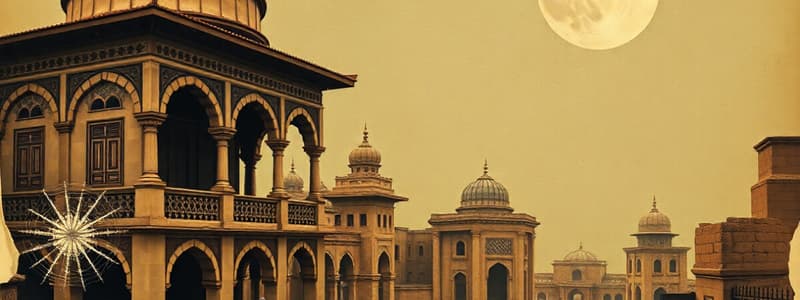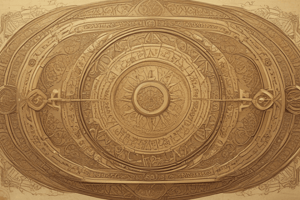Podcast
Questions and Answers
The House of Wisdom in Baghdad played a crucial role in the preservation of knowledge during the Islamic Golden Age. Which statement best describes its primary contribution?
The House of Wisdom in Baghdad played a crucial role in the preservation of knowledge during the Islamic Golden Age. Which statement best describes its primary contribution?
- It concentrated on developing new religious doctrines, using existing texts to support theological arguments.
- It focused solely on original research, disregarding previous scholarly works from other civilizations.
- It systematically collected and translated texts from various cultures, ensuring the survival of classical knowledge. (correct)
- It primarily functioned as a library for storing Arabic literature, with limited engagement in translation activities.
'The Canon of Medicine' by Avicenna became a foundational text in European medical schools for over 500 years. This longevity and influence most strongly indicates:
'The Canon of Medicine' by Avicenna became a foundational text in European medical schools for over 500 years. This longevity and influence most strongly indicates:
- Medical knowledge stagnated after Avicenna, with no significant advancements for centuries.
- The translation of 'The Canon of Medicine' into Latin was exceptionally accurate and preserved the original intent without error.
- The work synthesized and advanced medical understanding to such a degree that it remained a definitive resource for an extended period. (correct)
- European scholars lacked original medical thinkers during this period, depending solely on Islamic texts.
Islamic scholars adopted and refined the number system using digits 0-9, often called 'Arabic numerals'. What was the most significant advantage of this system over the Roman numeral system it replaced in Europe?
Islamic scholars adopted and refined the number system using digits 0-9, often called 'Arabic numerals'. What was the most significant advantage of this system over the Roman numeral system it replaced in Europe?
- Calculations, especially complex arithmetic and algebra, were significantly simpler using Arabic numerals and the concept of zero. (correct)
- Roman numerals could not represent large numbers, whereas Arabic numerals had no such limitations.
- Arabic numerals were visually more appealing and easier to write than Roman numerals.
- Arabic numerals were directly linked to religious texts, giving them greater cultural and societal importance.
The text mentions Islamic scholars making advancements in both 'algebra' and 'astrology'. While algebra is recognized as a scientific field, astrology is considered a pseudoscience. During the Golden Age, how were these two disciplines likely viewed and pursued in Islamic scholarship?
The text mentions Islamic scholars making advancements in both 'algebra' and 'astrology'. While algebra is recognized as a scientific field, astrology is considered a pseudoscience. During the Golden Age, how were these two disciplines likely viewed and pursued in Islamic scholarship?
Islamic hospitals of the Golden Age are described as having 'emergency rooms and surgical facilities' and 'paid attention to hygiene and sanitary conditions'. Which of the following best represents the significance of these features compared to medical practices in other parts of the world at that time?
Islamic hospitals of the Golden Age are described as having 'emergency rooms and surgical facilities' and 'paid attention to hygiene and sanitary conditions'. Which of the following best represents the significance of these features compared to medical practices in other parts of the world at that time?
The Golden Age of Islam is generally considered to have taken place during which historical period?
The Golden Age of Islam is generally considered to have taken place during which historical period?
What was a key factor that facilitated the intellectual and cultural flourishing during the Golden Age of Islam under the Abbasid Caliphate?
What was a key factor that facilitated the intellectual and cultural flourishing during the Golden Age of Islam under the Abbasid Caliphate?
The geographical reach of the Islamic empire during its Golden Age, from Spain to China, MOST directly contributed to which of the following?
The geographical reach of the Islamic empire during its Golden Age, from Spain to China, MOST directly contributed to which of the following?
Islamic art during the Golden Age is characterized by distinctive features EXCEPT:
Islamic art during the Golden Age is characterized by distinctive features EXCEPT:
Which of the following BEST exemplifies the lasting impact of Islamic scholarship from the Golden Age on contemporary society?
Which of the following BEST exemplifies the lasting impact of Islamic scholarship from the Golden Age on contemporary society?
Flashcards
Golden Age of Islam
Golden Age of Islam
A period of cultural, economic, and scientific flourishing in the history of Islam, lasting from the 8th century to the 13th century.
Islamic Calligraphy
Islamic Calligraphy
The art of beautiful handwriting, often used in Islamic manuscripts and architecture due to the discouragement of depicting human figures.
House of Wisdom
House of Wisdom
A major center of intellectual learning in Baghdad during the Abbasid caliphate, preserving classical knowledge and fostering new discoveries.
Abbasid Caliphate
Abbasid Caliphate
Signup and view all the flashcards
Dome of the Rock
Dome of the Rock
Signup and view all the flashcards
One Thousand and One Nights
One Thousand and One Nights
Signup and view all the flashcards
Translation Movement
Translation Movement
Signup and view all the flashcards
The Canon of Medicine
The Canon of Medicine
Signup and view all the flashcards
Arabic Numerals
Arabic Numerals
Signup and view all the flashcards
Islamic Algebra
Islamic Algebra
Signup and view all the flashcards
Study Notes
- Islamic scholarship is responsible for perfume, mapping, coffee, and the use of digits from 0-9.
- Scholars gathered at Baghdad's House of Wisdom to preserve classical knowledge and advance academic disciplines when Europe was in the Dark Ages.
- This House of Wisdom was one of many learning centers during Islam’s Golden Age.
- Islam began in the Arabian Peninsula in 610 CE.
- It spread quickly through conquest and conversion, and within a century, Muslims controlled an empire from Spain to China.
- The Abbasid caliphate gained control in 750 and moved the empire's capitol to Baghdad.
- During this dynasty, trade and ideas flowed freely across the empire.
- The Abbasids formed an advanced Islamic culture by appropriating ideas from conquered lands and Late Antiquity with contributions from various ethnicities and religions.
- The Arab world promoted both Muslim and non-Muslim scholars.
- These scholars significantly contributed to art, literature, science, medicine, and mathematics.
- Islam's Golden Age began with the Abbasid caliphate in 750 CE and lasted until the Mongol invasion in 1258.
Arts & Literature
- Islamic religious tradition discourages the depiction of human figures in religious art, so Muslim artists developed unique decorative elements.
- The art of glass blowing was perfected during this period.
- Miniature paintings adorned glass, silver, brass, and ivory objects.
- Manuscripts were written in calligraphy and meticulously illuminated.
- Royal robes and textiles featured lavish embroidery.
- Architecture combines many of these art forms.
- Islamic buildings borrowed domes and arches from the Byzantine Empire.
- They are adorned with calligraphy, geometric designs, and arabesques.
- The Dome of the Rock in Jerusalem was built in 691 CE on Judaism’s holiest site.
- The Dome of the Rock represents a political statement, religious monument, and display of grandeur.
- Its outer walls were originally tiled and the exterior of the dome, after being made of lead, is now covered in gold leaf.
- The interior of the dome is decorated with mosaics and calligraphy.
- The Golden Age produced many literary achievements, beginning with the House of Wisdom's opening under the fifth Abbasid ruler.
- Islamic scholars gathered and translated the world's knowledge into Arabic after learning Chinese papermaking.
- This effort preserved classical works from China, India, and Greece, including Aristotle and Plato.
- Muslim writers made commentaries, adapted folk tales, and composed original literature.
- "One Thousand and One Nights," also known as "The Arabian Nights," includes stories like Aladdin, Sinbad, and Ali-Baba.
- Libraries and bookstores were common in Baghdad, indicating a high literacy rate.
Science & Medicine
- Scholars contributed to the scientific world, including chemistry, alchemy, astronomy, and medicine.
- They improved scientific instruments like the astrolabe.
- They refined methods for recording scientific observations, leading to accurate calculations for the movements of the sun, moon, and planets.
- Islamic scholars analyzed Ptolemy's model of the universe, studied eclipses, and calculated the Earth's circumference.
- Pursuing the philosophy that Allah provided a cure for every disease, Islamic scientists made significant achievements in medical practice, education, and pharmacology.
- Specialists in ophthalmology, dentistry, psychiatry, and orthopedics treated injuries and illnesses.
- Hospitals had emergency rooms and surgical facilities with attention paid to hygiene and sanitary conditions.
- Islamic scientists experimented with cardiology and neurology.
- Avicenna compiled "The Canon of Medicine," which became Europe's authoritative medical textbook for over 500 years.
- Physicians attended medical school and had to pass exams before getting licenses.
- Pharmacology emerged as a separate discipline by the 12th century.
- Achievements included mixing sweet syrup with bitter medicine and anesthesia.
Mathematics
- Islamic contribution to the West was in mathematics.
- The digits 0-9, commonly called Arabic numerals, were adapted from India.
- An Italian scholar introduced the digit system to Europe after studying in a Muslim library.
- His publication in 1202 led to the widespread acceptance of Arabic numerals across Europe.
- Islamic scholars pioneered the study of algebra
- Islamic scholars wrote influential textbooks on the subject.
- Mathematicians pursued geometry, trigonometry, and used the decimal system.
Studying That Suits You
Use AI to generate personalized quizzes and flashcards to suit your learning preferences.




